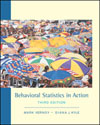 |  Behavioral Statistics in Action, 3/e Mark W. Vernoy,
Palomar College
Diana J. Kyle,
Fullerton College
t Tests
Glossary
| A t test | tests the null and research hypotheses used when the research design involves two samples. It tests the difference between the means of a sample and the population, two independent samples, or two correlated samples.
|  |  |  | | Degrees of freedom | is a statistical term used to denote the number of scores within any distribution that is free to vary without restriction in a sample with a fixed mean.
|  |  |  | | Sampling distribution of differences between means | is generated by taking two random samples and computing the difference between their means. By doing this a great number of times, a distribution is formed. If all the samples are selected from the same population or populations with equal means, the mean of this distribution is zero. If, on the other hand, there are two independent samples from populations that have different means, then the distribution of differences will have a mean equal to the difference between the two populations.
|  |  |  | | Standard error of the difference between correlated sample means | is the standard deviation of the distribution of the differences between paired means using the standard deviation and correlation coefficient.
|  |  |  | | Standard error of the difference between independent sample means | is the standard deviation of the distribution of the differences between sample means that is drawn from two independent populations.
|  |  |  | | The difference method | is used to compute the estimate of the standard error of the difference between means that uses the differences between paired scores, rather than the correlation coefficient and standard deviation.
|  |  |  | | The t distribution | is similar to the z distribution in it is also a symmetrical, bell-shaped sampling distribution. But, the overall shape of the t distribution is influenced strongly by the sample size used to generate it. For very large samples, the t distribution approaches the z distribution, but for smaller samples, the t distribution is flatter.
|
|



 2002 McGraw-Hill Higher Education
2002 McGraw-Hill Higher Education

 2002 McGraw-Hill Higher Education
2002 McGraw-Hill Higher Education